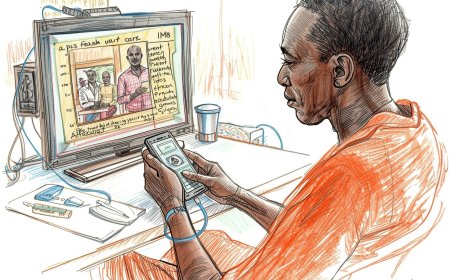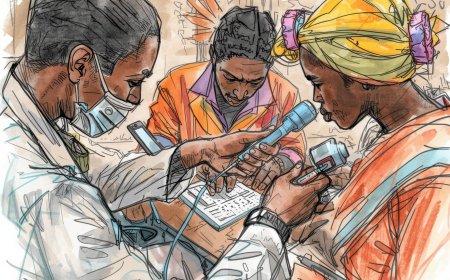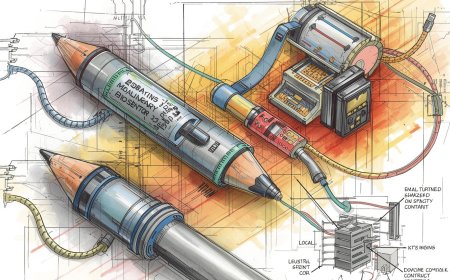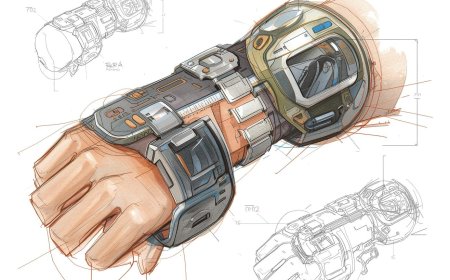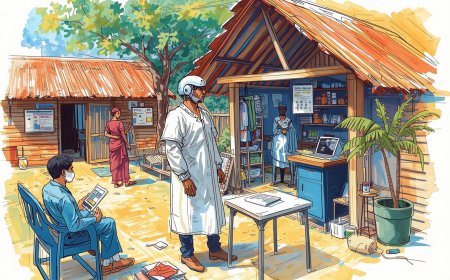Designing Low-Cost Wearables for African Climates and Lifestyles
A practical, Africa-focused guide to designing affordable, rugged, and culturally appropriate wearable devices. Covers climate-resistant hardware, low-power strategies, offline-first software, local validation, manufacturing partners, business models, and a step-by-step design-to-market checklist. Includes real citations (APA) with live links and down-to-earth African case studies — plus a cheeky lab-tech anecdote to keep night-shift nurses awake.

Short version: If your wearable melts, dies, or gets dusty in the first two weeks, it will be a very expensive paperweight. This guide shows how to design devices that survive sun, sweat, sand and sari-wrapping, connect on patchy networks, respect privacy, and — crucially — people will actually wear.
Opening anecdote (rib-cracker, but true-ish)
“Njeri built a heart-rate band that looked so elegant you’d wear it to a wedding. On day three, the clasp corroded from sweat and dust, the battery swore off charging, and Njeri’s aunt washed it in a bucket 'because it looked dirty'. Lesson: design for weddings, weather, and washing — in that order.”
Design for African lifestyles — which include outdoor markets, manual labor, extended family sharing, and frequent power outages — or the device will be fabulous on paper and useless in a hand.
Why low-cost, climate-aware wearables matter in Africa
Wearables can monitor chronic disease, occupational heat stress, maternal health, and population-level exposures. Early evidence suggests wearables are promising in low- and middle-income countries (LMICs) but face context-specific hurdles (data quality, representativity, access). To succeed, design choices must respond to connectivity constraints, extreme temperatures/humidity, dust, and cultural acceptability. PMC+1
Mobile connectivity and smartphone adoption are rising across Africa, but meaningful gaps remain — design for a mix of smartphone-tethered and standalone operation. GSMA reports show progress in mobile internet penetration, but affordability and network quality still vary widely by country and region. gsma.com
Core design principles
1. Build for climate: heat, humidity, dust, and the odd downpour
-
Ingress protection (IP) ratings matter. Aim for IP66 (dust-tight, protected from powerful water jets) or IP67 (dust-tight and temporary immersion) depending on use case and cost. Use conformal coatings on PCBs and corrosion-resistant materials for clasps and charging ports. IEC/ISO standards document IP codes and test methods. iec.ch+1
-
Thermal management. Electronics degrade quicker at high temperatures. Use components rated for extended temperature ranges, provide thermal paths to the enclosure, and avoid heat-trapping designs. Field tests in rural Africa show climate exposure significantly affects device readings and failure rates. JMIR mHealth and uHealth+1
Quick design check: Pick a target IP rating early and design the case, connector type (magnetic pogo pins vs exposed micro-USB), and seals around that requirement.
2. Low-power first — batteries & charging must match life on the ground
-
Use low-power MCUs and BLE or NB-IoT/LTE-M where network exists. When possible, design for multi-day battery life (7–14 days ideal) to survive users who forget nightly charging or lack daily electricity. Energy harvesting (solar trickle-charging, kinetic) can help but rarely fully replaces batteries — treat it as an extender, not a primary source. PMC
Practical tip: Offer a cheap, robust charging option (e.g., USB-C with a rubber flap, or a magnetic pogo-pin cradle) and test charging using local power adapters and solar banks.
3. Offline-first & sync-when-ready
-
Design apps and firmware that store data locally and perform secure sync when connectivity is available. This handles spotty networks and reduces data costs for users who pay per MB. Studies recommend offline-capable designs for rural and peri-urban deployments. MDPI+1
4. Simplicity, durability, and cultural fit (they must want to wear it)
-
Use neutral, durable straps and multiple sizing options. Provide discreet, culturally sensitive form factors (e.g., clip-on pendants or patch sensors) for populations that may dislike visible tech. Include local language prompts and minimal UX steps — test with the intended demographic. Acceptance studies in African settings show design aesthetics and comfort strongly influence adoption. PMC+1
5. Data privacy, ethics & local regulation
-
Even low-cost devices collect health data. Follow ethical best-practices: clear consent, minimal data collection, local data residency or transparent export rules, and secure transport (TLS). WHO digital-health strategy emphasizes appropriate use of digital tech in context-sensitive ways. World Health Organization
Hardware choices & materials (practical, cost-aware)
Enclosure & straps
-
Use ABS+PC blends or TPU for flexible parts — balance cost and UV resistance. Stainless steel or nickel-free alloys for clasps reduce corrosion and allergic reactions. For reusable adhesive patches, choose hypoallergenic medical-grade adhesives tested in humid climates.
Connectors & charging
-
Prefer magnetic pogo pins with sealing or USB-C with protective flaps rather than exposed micro-USB. If you choose an uncovered port, expect corrosion and failure in months. Ruggedized connectors raise BOM cost but lower long-term field failure and warranty costs.
Sensors & electronics
-
Choose sensors rated for extended temperature/humidity where possible. Use low-power sensor fusion to reduce sampling frequency while preserving accuracy (e.g., adaptive sampling for accelerometers/HR). Field studies show consumer-grade wearables can deliver usable data but need calibration and local validation. PMC+1
Protective coatings
-
Apply conformal coating (e.g., silicone or acrylic) to PCBs for humidity/dust protection. This adds cost but prevents many field failures.
Software & connectivity patterns
Offline-first architecture
-
Data stored encrypted on-device; sync batch uploads when connected (Wi-Fi or mobile). Provide patient-facing SMS fallbacks or USSD prompts for low-end phones.
Minimal data & edge processing
-
Preprocess data on the device (e.g., compute summary metrics, detect anomalies) to reduce upload size and preserve battery.
Local-language UX & low-literacy design
-
Use iconography, audio prompts, and minimal text. Test with the real user base (market stalls, farms, peri-urban clinics).
Security
-
Use TLS for transport, device attestation for firmware updates, and role-based access on the backend. Keep PII to a minimum and present clear consent flows.
Validation & field testing — don’t skip local studies
Clinical and usability validation should occur in the target climate and population. Papers show that wearables can be effective in LMIC contexts but performance and acceptability vary — validate both measurement accuracy and human factors (comfort, wear time, cultural fit). Typical steps:
-
Bench testing (lab thermal cycles, dust chamber, humidity).
-
Pilot field study (n = 50–200 depending on endpoints) in representative settings.
-
Usability study (observe wear and charging behaviour, acceptability). PMC+1
Manufacturing & partners — localize where possible
-
Local assembly or CMs: Contract manufacturers in Africa reduce shipping, import duties, and build local jobs. PATH and other organisations track local manufacturers and can help with tech transfer. enclosurecompany.com+1
-
Design for manufacturability (DFM): Keep parts count low, use common fasteners, and design for inexpensive assembly methods.
-
Quality systems: Implement basic quality documentation and incoming inspection; for medical applications, work toward ISO 13485.
Business models that work in African contexts
-
Device + service: subsidize device via donors or employers; charge per-month for data/analytics.
-
Pay-as-you-go (PAYG): micro-payments for device financing via mobile money (M-Pesa, MTN MoMo) — popular and practical. GSMA work on device affordability and mobile payment access supports such models. gsma.com+1
-
B2B to clinics or employers: sell to occupational-health programs (miners, agriculture co-ops) with recurring service fees.
-
Hybrid donor procurements: partner with NGOs for subsidised rollouts, but design to transition to sustainable models.
Case study 1 — The Market Nurse Band (fictional, realistic)
A start-up designed a rugged clip-on heart-rate/sleep tracker for night-market vendors. Key design choices:
-
IP66 plastic enclosure, magnetic pogo charging with rubber seal.
-
10-day battery life, low-power BLE with batch sync at market closing.
-
Offline-first app with SMS fallback for non-smartphone users.
-
Sold through microfinance PAYG (M-Pesa installments).
Result: High adoption among vendors who appreciated long battery life and simple charging. A few units failed due to clasp corrosion — fixed in V2 with stainless clasp and conformal-coated PCB.
Case study 2 — HeatSafe patch for farmworkers (pilot summary)
A research pilot used low-cost temperature/humidity patches to monitor heat stress in field workers. The devices used summary metrics and SMS alarms for supervisors. Field testing showed sensor drift at extreme humidity unless simply recalibrated in local labs every 6 months; the project switched to sealed patches and scheduled calibration to improve reliability. The study underscores the need for ongoing maintenance plans in hot-humid climates. PMC+1
Regulatory & standards checklist (practical)
-
Ingress protection (IEC 60529) — pick and test to IP rating early. iec.ch
-
Electrical safety & EMC — follow regional directives or IEC equivalents.
-
Data protection & privacy — follow national law (e.g., Kenya Data Protection Act, Nigeria NDPR, South Africa POPIA) and best practices (minimal PII, consent). World Health Organization+1
-
Medical device regs — if your wearable claims diagnosis or clinical use, follow national medical device registration (may require ISO 13485). Engage regulators early.
Field deployment & maintenance — the reality checklist
-
Provide a local spare-parts plan (straps, chargers).
-
Offer local training and a simple escalation pathway.
-
Plan firmware OTA that tolerates intermittent networks (delta updates).
-
Run a warranty & repair policy suited to expected field failure rates (e.g., 90-day warranty + paid repairs).
Step-by-step roadmap (copy into your product notebook)
Month 0–3: Define use-case, target populations, and target IP/battery specs; build basic prototype.
Month 3–6: Lab bench tests (thermal cycles, dust), apply conformal coating, choose charging approach. iec.ch+1
Month 6–9: Pilot field study (usability + technical accuracy) in representative climate; collect wear-time data. JMIR mHealth and uHealth+1
Month 9–12: Iterate design, finalize DFM for local assembly, begin quality documentation.
12+ months: Scale manufacturing, deploy larger field studies, establish distribution and PAYG or B2B channels.
Quick one-page checklist to pin over the workbench
-
Target IP rating chosen (e.g., IP66/IP67)? Y/N. iec.ch
-
Battery life target ≥ 7 days? Y/N.
-
Offline-first data & SMS fallback designed? Y/N. MDPI
-
Local validation plan in target climate? Y/N. JMIR mHealth and uHealth
-
Charging solution tested on local power/solar banks? Y/N.
-
Manufacturing partner or CM identified regionally? Y/N. enclosurecompany.com
Further reading — APA references with live links
Canali, S., et al. (2022). Challenges and recommendations for wearable devices in clinical and public-health settings. npj Digital Medicine. https://www.ncbi.nlm.nih.gov/pmc/articles/PMC9931360/. PMC
Swahn, M. H., Gittner, K. B., Lyons, M. J., Nielsen, K., Mobley, K., Culbreth, R., Palmier, J., Johnson, N. E., Matte, M., & Nabulya, A. (2024). Advancing mHealth research in low-resource settings: Young women’s insights and implementation challenges with wearable smartwatch devices in Uganda. Sensors, 24(17), 5591. https://doi.org/10.3390/s24175591. https://www.mdpi.com/1424-8220/24/17/5591. MDPI
Matzke, I., et al. (2024). Assessment of heat exposure and health outcomes in rural settings using wearable devices. JMIR mHealth and uHealth. https://mhealth.jmir.org/2024/1/e54669. JMIR mHealth and uHealth
Sachdeva, M., et al. (2025). Are wearables effective in LMICs? A systematic review. Journal of Global Health / PubMed Central. https://www.ncbi.nlm.nih.gov/pmc/articles/PMC12098041/. PMC
International Electrotechnical Commission. (n.d.). IP ratings (IEC 60529) — Ingress protection. https://www.iec.ch/ip-ratings. iec.ch
GSMA. (2024). The State of Mobile Internet Connectivity 2024 (report). https://www.gsma.com/r/wp-content/uploads/2024/10/The-State-of-Mobile-Internet-Connectivity-Report-2024.pdf. gsma.com
PATH. (n.d.). Diagnostics and device manufacturer resources; local manufacturing support. https://www.path.org/who-we-are/programs/diagnostics/diagnostic-manufacturer-in-low-and-middle-income-countries/. linak-us.com
Koch, M., et al. (2023). Assessing the effect of extreme weather on population health using wearables. Environmental Health / PubMed Central. https://www.ncbi.nlm.nih.gov/pmc/articles/PMC10666008/.
What's Your Reaction?
 Like
0
Like
0
 Dislike
0
Dislike
0
 Love
0
Love
0
 Funny
0
Funny
0
 Angry
0
Angry
0
 Sad
0
Sad
0
 Wow
0
Wow
0





